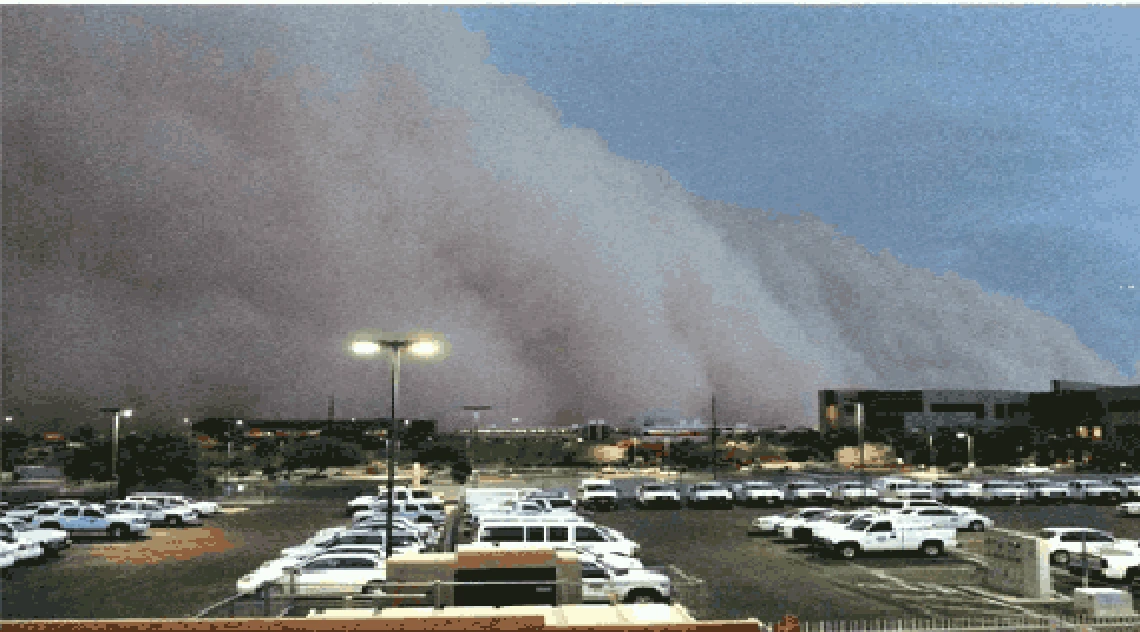UA SRP Presents at the NOAA National Weather Service 2016 Southern Arizona Dust Storm Workshop


These days, we are no stranger to wind and airborne dust in southern Arizona. Already this spring we’ve had 40 mph gusts closing down highways and driving up spring allergies. The term, “haboob”, has found its way into our vocabulary and, even if we haven’t personally found ourselves face-to-face with one of these walls of dust, we can often see the layer of matter lying over the horizon.
These rising concerns about dust safety and mitigation issues were discussed at the National Weather Service, National Oceanic and Atmospheric Administration’s 5th Annual Arizona Dust Storm Workshop, held on March 21, 2016 in Coolidge, AZ. Mr. Kyle Rine, Environmental Measurements Coordinator with the University of Arizona Superfund Research Program (UA SRP), participated in the workshop, presenting UA SRP dust research in his talk: “Measurements of Threshold Velocities on Abandoned Agriculture Fields near Picacho Peak using a Portable Dust Generator. In his talk, which showcased measurement technologies applicable to all hazardous dust sites (including his research team’s SRP field sites), Mr. Rine discussed the emerging technology of portable wind tunnels and provided examples of local field studies where his team’s portable wind tunnel was used, including the UA SRP Iron King Mine and Humboldt Smelter Superfund site. Mr. Rine also discussed how his team’s current work in measuring dust production at various surface friction velocities is being used to measure the generation of airborne dust, concluding his talk by discussing the relevance of this work and how it will be applicable to creating dust mitigation strategies and warning systems.
 Mr. Rine started his dust research career as an undergraduate working with UA SRP investigators Dr. Eduardo Saez and Dr. Eric Betterton. Since completing his degree, he has taken a leadership role in the research group where he executes field work and data collection for these dust studies. The team hopes that in addition to better understanding dust emissions from mine tailings sites, their work will also help answer some fundamental questions about dust production on the Interstate 10 dust corridor that links Tucson and Phoenix. After the conference, Mr. Rine summed up the importance of his presentation at the workshop: “The soil situation in the I-10 dust corridor is very complex and varied. (At the conference) I was able to talk about how the instrument we built is ideal for filling in these data gaps.”
Mr. Rine started his dust research career as an undergraduate working with UA SRP investigators Dr. Eduardo Saez and Dr. Eric Betterton. Since completing his degree, he has taken a leadership role in the research group where he executes field work and data collection for these dust studies. The team hopes that in addition to better understanding dust emissions from mine tailings sites, their work will also help answer some fundamental questions about dust production on the Interstate 10 dust corridor that links Tucson and Phoenix. After the conference, Mr. Rine summed up the importance of his presentation at the workshop: “The soil situation in the I-10 dust corridor is very complex and varied. (At the conference) I was able to talk about how the instrument we built is ideal for filling in these data gaps.”
Mr. Rine had the opportunity to attend diverse talks and meet speakers who participated in the workshop. In addition to presentations from university researchers and an expert panel comprised of regulatory agency personnel, the roles of the public and media were represented by TV news meteorologists and Arizona State Senator, Steve Farley. Amber Sullins, Chief Meteorologist for ABC 15 in Phoenix, talked about the media’s crucial role in providing dust warnings and safety education for the public. Finally, an expert panel discussed potential strategies for dust mitigation. After the workshop Mr. Rine said: “I was impressed by the work being done by everyone at the conference. Although we have a long way to go before we can reach any real solution, it’s clear that progress is being made. The work being done on the I-10 corridor has the potential to save lives, and it’s heartening to know that so many talented and dedicated professionals are searching for ways to mitigate the dust problems on I-10.”


